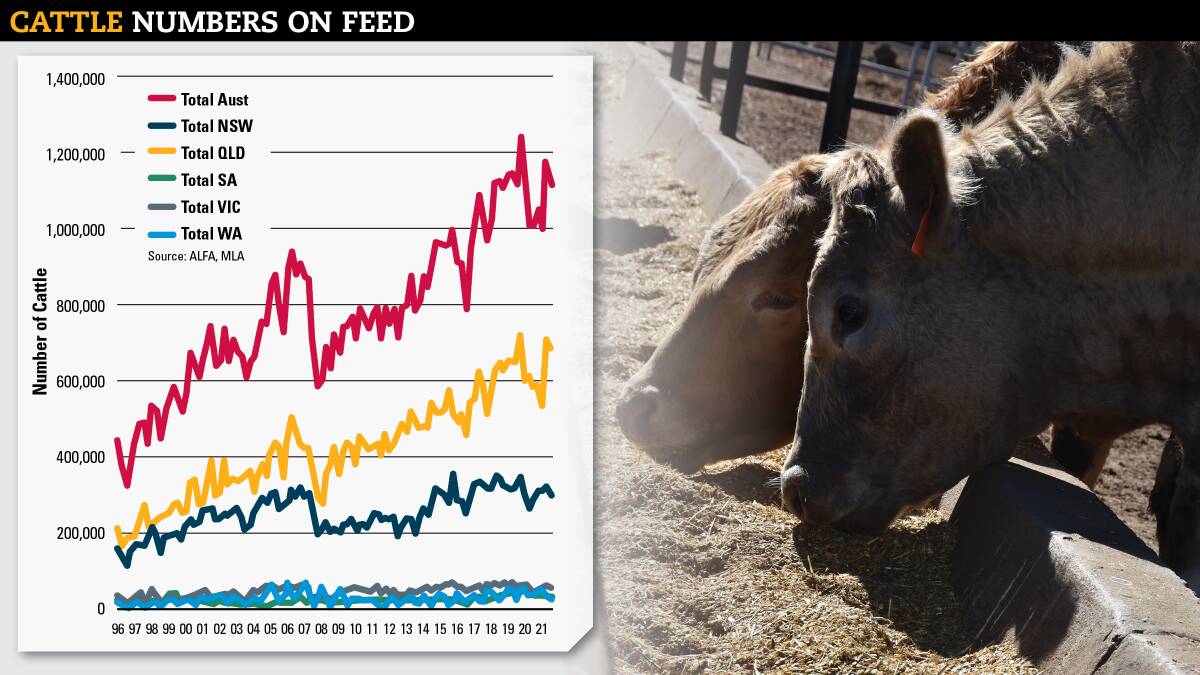
The shift in producer mindset towards selling younger males to feedlots rather than feeding them out on grass to processor rates is expected to continue as grain-fed beef demand goes from strength to strength.
Subscribe now for unlimited access to all our agricultural news
across the nation
or signup to continue reading
Last year, for the first time ever, 50 per cent of domestically consumed beef was from lot-fed cattle.
Numbers on feed have now been above the 1 million mark for 15 consecutive quarters and analysts believe it's unlikely they will ever again drop below that.
Feedlots are currently buying more than 50pc of Eastern Young Cattle Indicator eligible cattle.
Meat & Livestock Australia's February cattle industry projections show feedlot capacity is at a record level of 1.4m head, with utilisation at 77 per cent.
Market information manager Stephen Bignell said expansion projects were in the pipeline which would further boost that capacity.
Speaking at an MLA-hosted cattle projections webinar, Mr Bignell said the number of cattle on feed has doubled since 2008.
"Last year, slaughter hit the lowest level it has been at in 35 years and the feedlot sector sourced 2.85m head and provided enormous continuity of supply," Mr Bignell said.
ALSO IN BEEF:
Through 2022, MLA expects the feedlot sector to continue to be a prominent component of the industry.
Mr Bignell said a lot of cattle were being fed for longer, and to heavier weights, because under current conditions it was more cost effective to add kilograms rather than enter the market and source cattle again.
"That trend has been driven by price and we expect it to continue into 2022," he said.
Supermarket and Wagyu programs have become more pronounced. Wagyu last year made up around 15pc of all grain-fed cattle slaughtered.
Australian Lot Feeders' Association president Barb Madden said the feedlot industry had grown from a capacity of about 1.2m head to 1.4m in five years and it was expected this gradual, consistent expansion would continue.
"At present, expansion is predominantly occurring in Queensland, however we are seeing expansion in other key states as well," she said.
The number of grain-fed cattle turned off is forecast to be the same this year, however the proportion of grain-fed beef will fall given grass-fed volumes will increase as the herd rebuild matures.
"We have had two bumper grain harvests in Australia so there is an abundance of grain but the caveat is global factors mean the domestic price isn't as low as you'd otherwise expect," Mr Bignell said.
Still, lot feeders say the lower grain price is offsetting high cattle prices for the most part.
NSW's Andrew and Tess Herbert plan to upsize their Gundamain feedlot near Eugowra in the Central West from 6000 head to 10,000.
Mrs Herbert said there was strong optimism in the lotfeeding sector at the moment.
"We've had a really good grain harvest of our own and we are now able to access grain from neighbours, rather than the long transport that was needed in drought," she said.
"Sourcing cattle is hard and it certainly makes sense to keep them on longer at the moment rather than compete with restockers in the market."
Mrs Madden said the strong driver of confidence within the sector was the global demand for premium protein.
"In a marketplace that relies upon uninterrupted delivery to the end consumer, feedlots allow for consistency of supply and quality," she said.
"Processors are looking for guaranteed supply that gives them confidence to keep processing plants operating at a level that will meet this global demand.
"In addition to this is the growth of beef brands, and the strong demand both here and overseas for those brands. All the signs are pointing towards sustained and increasing demand for grain-fed beef, placing the industry in a positive position."
However, like all of agriculture at present, a shortage of skilled labour was a big challenge, she said.
"ALFA has taken steps to provide a clear career development pathway and associated training, professional development and support networks designed to attract, retain and grow the capacity of the feedlot workforce through the Feedlot Career Development and Training Project," Mrs Madden said.
"Despite the important role this project is playing, we see timely delivery of the federal government's Agriculture Visa program as a key solution to the immediate labour issue."
For all the big news in beef, sign up below to receive our Red Meat newsletter.


